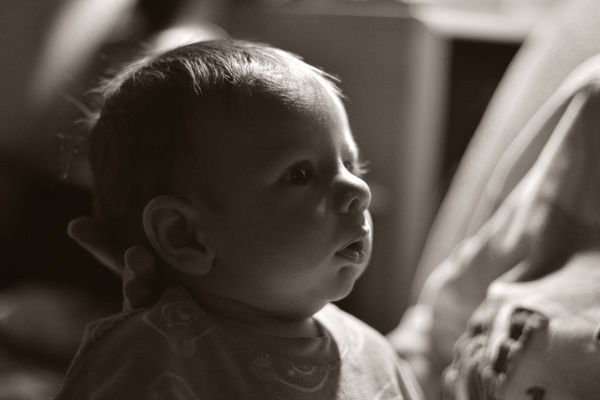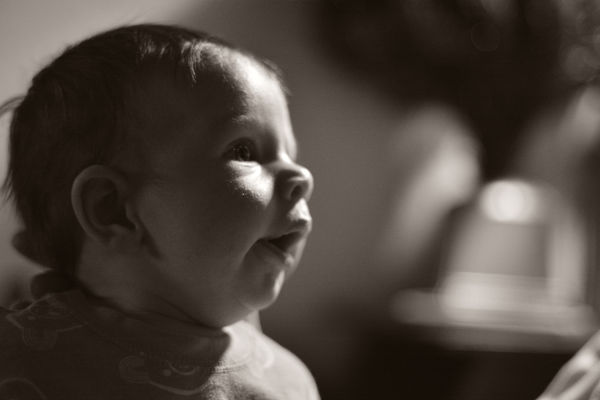Famous "Banding" from the Nikon D7100!
Dec 14, 2020 09:12:56 #
~ The following images show the banding that the Nikon D7100 with the Toshiba sensor is “famous” for (I’m sure there are others!). I have really never encountered this phenomenon so clearly as in these images. These images will only be printed to 5x7 inches, so not too big a deal for me here, but still….!
~ All were shot purposely with existing low light @ F 1.4 (50mm Nikkor AF). The culprit to the banding, of course, is the “High” ISO in the mid to low 1000 range and minus 1.7 stops of exposure compensation dialed in for low light effect. Honestly, in my mind, this performance would be a real problem in most situations!
~ I think I’ll experiment with my Olympus OM-D 10.1 and see for comparison how it will handle shadow detail in a similar situation!
These images are SOOC except for resizing for posting…..


~ All were shot purposely with existing low light @ F 1.4 (50mm Nikkor AF). The culprit to the banding, of course, is the “High” ISO in the mid to low 1000 range and minus 1.7 stops of exposure compensation dialed in for low light effect. Honestly, in my mind, this performance would be a real problem in most situations!
~ I think I’ll experiment with my Olympus OM-D 10.1 and see for comparison how it will handle shadow detail in a similar situation!
These images are SOOC except for resizing for posting…..


Dec 14, 2020 09:15:14 #
Dec 14, 2020 09:27:47 #
Minitman
Loc: Centreville, Virginia
Hope someone can give you some sound advice/opinion. I've had similar issues (see below) so it may not be your lens.
I've experienced more severe "banding" from time to time with my D750 and the 24 -120mm lens (many have zoom range wrong). Mine always comes up when using the in camera flash and it doesn't happen all the time and never happens with an external flash.
I've experienced more severe "banding" from time to time with my D750 and the 24 -120mm lens (many have zoom range wrong). Mine always comes up when using the in camera flash and it doesn't happen all the time and never happens with an external flash.
Dec 14, 2020 09:42:39 #
Minitman wrote:
Hope someone can give you some sound advice/opinion. I've had similar issues (see below) so it may not be your lens.
I've experienced more severe "banding" from time to time with my D750 and the 24 -120mm lens (many have zoom range wrong). Mine always comes up when using the in camera flash and it doesn't happen all the time and never happens with an external flash.
I've experienced more severe "banding" from time to time with my D750 and the 24 -120mm lens (many have zoom range wrong). Mine always comes up when using the in camera flash and it doesn't happen all the time and never happens with an external flash.
Thank you for your comment, Minitman!
~Yeah, Not a lens problem, Luv that lens! This wasn't a looking for advice, per se, posting. Just showing an annoying electrical fault in a particular camera (Nikon D7100) at moderate high ISO's!
The advice would be to probably use my D7000. I've never heard of banding from it. I could be wrong though...I frequently am!


Dec 14, 2020 09:47:48 #
yorkiebyte wrote:
~ The following images show the banding that the Nikon D7100 with the Toshiba sensor is “famous” for (I’m sure there are others!). I have really never encountered this phenomenon so clearly as in these images.
What are you referring to. I am unable to see anything wrong with the photos other than questionable lighting. Please add additional specifics. Thank you
Dec 14, 2020 09:49:19 #
Brian S. wrote:
What are you talking about. I am unable to see anything wrong with the photos other than questionable lighting. Please add additional specifics. Thank you
Take the first image, open the attachment and view the 1:1 pixels in the dark upper left corner. You'll see horizontal stripes in the grain of the noise, particularly between the child's eye and ear.
Dec 14, 2020 09:53:05 #
CHG_CANON wrote:
Take the first image, open the attachment and view the 1:1 pixels in the dark upper left corner. You'll see horizontal stripes in the grain of the noise, particularly between the child's eye and ear.
Thanks. I was not trying to hurt any ones feelings and I can see it now. Not a Nikon user so I was not aware of the problem.
Dec 14, 2020 09:53:27 #
yorkiebyte wrote:
~ The following images show the banding that the N... (show quote)
How much exposure adjustment was performed in the processing? The first image reports PSE-14, not the most advanced digital processor. In reworking underexposed images from an EOS XTi, circa 2006 - 2011, I can find similar banding when trying to correct in post mistakes made when the image was captured. Being aware of the limitations of the equipment is the best way to avoid exposing those limitations.
Dec 14, 2020 10:03:13 #
yorkiebyte wrote:
~ The following images show the banding that the N... (show quote)
Major error dialing in -1.7EV for a “low light effect”. Doing that embedded under exposure flaws in your image file. If you want -1.7EV darkening, do that in post. Acoarst if you shun post, then you can’t blame the sensor for your problems.
Dec 14, 2020 10:04:17 #
CHG_CANON wrote:
How much exposure adjustment was performed in the processing? The first image reports PSE-14, not the most advanced digital processor. In reworking underexposed images from an EOS XTi, circa 2006 - 2011, I can find similar banding when trying to correct in post mistakes made when the image was captured. Being aware of the limitations of the equipment is the best way to avoid exposing those limitations.
The images were resized only in PSE 14. No other adjustment as I was just showing what I consider to be a known sensor fault.
~ I will be exploring my D7000 and Oly OM-D 10.1 to see if I can improve on this annoying situation! Won't be losing any sleep either way - Not a paying job these images!


Dec 14, 2020 10:20:39 #
User ID wrote:
Major error dialing in -1.7EV for “low light effect”. Doing that embedded under exposure flaws in your image file. If you want -1.7EV darkening, do it in post. Acoarst if you shun post, then you can’t blame the sensor for your problems.
No post here except resize (not that I'm averse to it!) - these images were posted primarily to show the banding.
~ Yes, post-work would be better on these for sure if properly exposed. Thank you, User ID, great advice. I do get lazy at times and hope the really smart camera will fix all my problems!! Haha!!
~Actually, I would like to blame the sensor for ALL of my problems - Bank account, low on beer, bad knee/back, and more!!
More experimentation! Luv it!! ...Whooohoo!!


Dec 14, 2020 10:24:59 #
vanderhala
Loc: Los Angeles, CA
CHG_CANON wrote:
Take the first image, open the attachment and view the 1:1 pixels in the dark upper left corner. You'll see horizontal stripes in the grain of the noise, particularly between the child's eye and ear.
Still don't see it (old MacbookPro 17 inch). Maybe time for a new monitor :)
Dec 14, 2020 11:14:45 #
vanderhala wrote:
Still don't see it (old MacbookPro 17 inch). Maybe time for a new monitor :)
Look at the cheek and towards the ear - kinda' like scratches on real film from bad machine processing!
I'm looking at this on a 15" HP laptop right now.



Dec 14, 2020 11:26:32 #
vanderhala
Loc: Los Angeles, CA
yorkiebyte wrote:
Look at the cheek and towards the ear - kinda' like scratches on real film from bad machine processing!
I'm looking at this on a 15" HP laptop right now.


I'm looking at this on a 15" HP laptop right now.


I see it but underwhelmed. Thanks.
Dec 14, 2020 11:28:18 #
CHG_CANON wrote:
How much exposure adjustment was performed in the processing? The first image reports PSE-14, not the most advanced digital processor. In reworking underexposed images from an EOS XTi, circa 2006 - 2011, I can find similar banding when trying to correct in post mistakes made when the image was captured. Being aware of the limitations of the equipment is the best way to avoid exposing those limitations.
So, would a Newer version of PSE (i.e. "21") would process images better (or are we talking about MY brain processing power, that may be suspect at best!)?
~ I ask this mainly because I'm building a new PC for my Oregon beach cabin so as not to have to use this crappy laptop or transfer my AZ home PC to Oregon!
Using PSE 14 now.
 And no, I don't want the subscription version - I'm no longer shooting Pro!
And no, I don't want the subscription version - I'm no longer shooting Pro! 
If you want to reply, then register here. Registration is free and your account is created instantly, so you can post right away.





